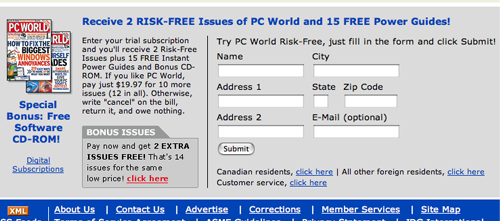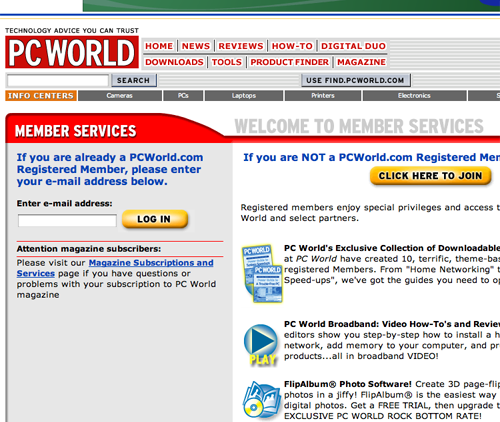PC World Makes OFIEs Work by Giving Them Prominent Placement Near Editorial, Making an Email Address Optional and Offering Plenty of Premiums
OFIEs, “Order Forms in Editorial” are embedded subscription forms. They are placed in unused space at the bottom of webpages and, when used to generate subscriptions to a companion print magazine, churn thousands of new orders per year at virtually no cost. PC World is a perfect example. “Our website (www.pcworld.com) is our most profitable new business source for the magazine,” says Shawne Pecar, vice president of consumer marketing at PC World.
“The embedded sub form on the website has proven to be a very strong, extremely reliable, and particularly worthwhile generator of new subscriptions to the print magazine.” While Pecar won’t reveal numbers for PC World, the word is in the industry, among publishers who routinely utilize OFIEs, that they have the potential of tripling new subscription orders generated online.
- OFIEs are very large, coupon-style ads on the bottom of the page and simply require a new subscriber to supply his or her name and address and click “submit”
- The key to OFIE effectiveness is prominent placement as close to the editorial content as possible
- Offering premiums to new online subscribers is a must—PC World is currently offering new subscribers a whopping 15 free “power guide” premiums, formatted as downloadable PDFs, along with a CD-ROM of bonus software
- Be sure to give subscription promotions as much presence as possible on the website’s homepage, so people can always find an easy way to subscribe
- Use pop-up ads (although their effectiveness may be changing), place subscription offers in banner ads whenever an opportunity arises for a house ad and make sure your online customer service area is easy to find and easy to use
[text_ad]
Introduction
Affectionately called OFIEs, “Order Forms in Editorial” are actually embedded subscription forms that appear on webpages and, indeed, are very much entitled to the respect, consideration, and perhaps even affection of circulators. Basically, OFIEs are placed in unused space at the bottom of webpages and, when used to generate subscriptions to a companion print magazine, churn thousands of new orders per year at virtually no cost. For a circulator, it doesn’t get much better than that. PC World is a perfect example.

Example of PCWorld OFIE
While online subscription generation is not the highest source of new business for PC World, it is the best source based on the lowest cost per order. “Our website is our most profitable new business source for the magazine,” says Shawne Pecar, vice president of consumer marketing at PC World. “The embedded sub form on the website has proven to be a very strong, extremely reliable and particularly worthwhile generator of new subscriptions to the print magazine.”
While Pecar won’t reveal numbers for PC World, the word in the industry, among publishers who routinely utilize OFIEs, is that they have the potential of tripling new subscription orders generated online.
PC World has placed embedded sub forms on PCWorld.com since February of 2003, when they were added to the bottom of each webpage, following the editorial content, as part of a major website redesign. The immediate result was a huge lift in new orders that reached 30 to 40 percent above normal, according to Pecar. “A second, smaller redesign was done later that fall, in October 2003, which again lifted orders,” she notes.
“Anything I can do to grow orders on our website is a high priority,” states Pecar. “We have all sorts of subscriber links on our website. Embedded subscription forms are only one source. My goal is to provide several ways to subscribe to our magazine on every page of the site. And as our site traffic grows and attracts new unique visitors, they become the perfect new prospects for me to convert to magazine subscribers.”
PC World, the Brand
PC World magazine and PCWorld.com are published by PC World Communications, Inc., a subsidiary of International Data Group (IDG), a privately held company.
- PC World magazine has a paid circulation of 850,000 and a readership estimated at 5,581,000 (MRI, Spring 2005). The mean reading time per issue is 54 minutes (MRI, Spring 2005).
- PCWorld.com, the magazine’s companion website, boasts 5.3 million unique visitors per month (Hitbox, July 2005) and an average time spent per visit of five minutes, 33 seconds (Hitbox, July 2005). The site posts 100 percent of the magazine editorial content, plus an estimated 50 percent of additional content from other sources.
Although all of the articles appearing in the print magazine are available for free on PCWorld.com, the plan is to begin monetizing the online content so it’s not all free. As a first step, the magazine area on the site—where the current issue and back issues appear the same way they do in print—was recently walled off for subscriber access only. The subscriber must provide an account number upon entering the area for the first time; a cookie allows future access without signing in.

The magazine area on this site was recently walled off for subscriber access only.
“We’ve always had the current issue and back issues available for free on our website,” explains Pecar. “While all stories are still available online and for free, non-subscribers must now search individually for each story. Easy access to entire issues (both current and archives) in the walled-off area is a benefit for subscribers only.”
PCWorld.com has also recently become more of an ad-driven website, so PC World magazine has the luxury of placing banner ads for magazine subscriptions only if, and when, unsold space occasionally becomes available for a house ad. Therefore, Pecar relies on subtler placements—such as links on the homepage, links elsewhere on various pages and pop-up ads, in addition to the embedded sub forms at the bottom of each page.
OFIE Placement on the Page
Adding an OFIE to each webpage is analogous to having an insert card tipped onto the bottom of every page in a print magazine. The key to OFIE effectiveness, however, is placement in a prominent place on the webpage and as close to the editorial content as possible. “My recommendation is to make them as visible as possible,” says Pecar.
For design reasons that are beyond Pecar’s control, PC World‘s embedded order forms are less prominent than they were initially. Now, the reader must scroll well below the bottom of the screen to see them—and some of the webpages have gotten much longer than they were a year ago, due to the added advertising links. As a result, they are slightly less effective than when they first went live; nevertheless, they are still a strong and important source of new business, according to Pecar.
“We’ve been very successful with the embedded sub forms over the years and are now challenged to figure out new and better ways to continue doing it, as our webpages are once again being redesigned.”
Design Issues
The embedded subscription forms on PCWorld.com couldn’t be simpler in terms of design and fill-in requirements. They are very large, coupon-style ads on the bottom of the page and simply require a new subscriber to supply his or her name and address and click “submit.” That, according to Pecar, is its beauty.
Email Address (optional).
Much of the wisdom regarding customer email addresses has been, simply, to capture it whenever and wherever possible in order to facilitate free customer communication in the future. Interestingly, providing an email address is optional on PC World‘s embedded subscription form.
“We’re PC World,” Pecar reminds us, “and we write about privacy issues every month. Our readers get tons of email and spam and have been getting it longer than anybody. They know it’s absolutely not necessary for us to have their email address to fulfill their magazine subscriptions. So if we force them to provide an email address, we know for a fact—by tracking activity as people complete the embedded sub form—that they stop filling it and go away. Or, if you force people to give an email address, they may provide a bogus one. That’s why we make it optional.”
On some of its subscription forms (other than the embedded ones), PC World entices individuals to provide an email address by offering to send a free weekly newsletter. In that case, the individual receives a benefit and, therefore, feels more comfortable giving up an email address.
Premiums.
PC World is currently offering new subscribers a whopping 15 free “power guide” premiums on its online embedded sub forms, which are formatted as downloadable PDFs, along with a CD-ROM of bonus software. Because they’re downloads, no email address is necessary to deliver the premiums. (Those who order subscriptions offline—e.g., via traditional direct mail or insert cards—receive only the CD-ROM as a premium.)
“We started with five online premiums, then 10, and now 15,” says Pecar. “Basically, we’re compiling recent magazine articles into the ‘power guides.’ The editors constantly update the guides to keep the information fresh; if a topic becomes outdated, however, we replace it with something else.”
New subscribers can download all of the premiums or only those that are of particular interest. When the individual submits a subscription order, a confirmation page pops up with the links to download the PDFs. “We encourage them to bookmark the page so they can download them whenever they wish,” says Pecar. “And if they forget to bookmark the page, we will supply a special access URL upon request.” PC World doesn’t publicize the URL for obvious reasons.
“Bill me” Offer.
Research indicates that, in some cases, pay-up for an online offer without a required credit card payment can be as low as 15-20 percent. PC World offers a “bill me” payment option without a problem. PCWorld.com pay-up rates are “very good,” according to Pecar, because the person signing up for the subscription is a) already on the website when deciding to subscribe, and b) already familiar with the product.
“You get fewer orders if you force people to ‘pay now’ with a credit card,” she adds. “We want to present people with as few choices as possible. More importantly, the embedded sub form is not on a secure site, so we can’t ask for credit-card information when they’re filling out their name and address.” The form does have a link, however, where the new subscriber can click onto a secure webpage, hosted by PC World‘s fulfillment house, and pay with a credit card—and receive two free issues as a bonus.
Many publishers who sell subscriptions on their websites filter the good requests from the bad by requiring an email confirmation; without the confirmation, they trash the sub request. That practice improves total pay-up, but it can also knock up to 35 percent off the order volume. By making the email address optional in the order form, that extra filter is not available to PC World—but it’s also not a concern. “We do have checks and balances in place to eliminate bogus orders,” says Pecar, “such as checking the zip code against the city and state, discarding orders that include profanity, and so forth. But that’s no different from what we do with insert cards. It’s just part of the business.”
Renewals.
For PC World, renewal rates are “very good from anyone who initially orders from the website,” says Pecar. “They represent some of our highest renewal rates for first-time renewals and, therefore, are one of our highest renewal sources.” Further, the more years that people subscribe, the higher the renewal rates—which is another reason why the PCWorld.com website is such a profitable new-sub source for PC World magazine. “It’s profitable acquiring that first-year subscription and even more profitable year after year,” says Pecar.
… and Other Sources
The ratio of OFIE orders as a percentage of all new business for PC World varies from year to year based on how much direct mail and other promotions Pecar does offline and online. “We still put lots of insert cards in our magazines,” she says. “That has always been inexpensive and a no-brainer. But I can honestly say that insert-card response has definitely dropped off in recent years.” Pecar believes that’s because people don’t want to bother to fill out and mail those cards. They’d rather log onto the magazine website and enter an order that way.
PC World has also placed various pop-up ads on the website over the years, which also bring in orders. Pop-ups are less effective now, as pop-up lockers are becoming more apparent. Pecar does recommend giving subscription promotions as much presence as possible on the website’s homepage, so people can always find an easy way to subscribe to the magazine.
The embedded sub forms, however, are “very complementary” to the website, she says, and have become an integral part of doing business at PC World.
“A lot of other magazines are successfully using these embedded sub forms, as well. At a recent conference, I recommended adding an embedded sub form as a way to maximize more orders from the website. Yoga Journal took note, added them to YogaJournal.com, and has seen phenomenal results. Tennis magazine is about to start doing it, as well.”

Example of Yoga Journal OFIE
Last, but Not Least…
Pecar recently wrote an article for Subscription Marketing magazine, in which she listed some “must do” items for subscription marketers selling subs online. She itemizes them here:
- Ensure a prominent presence on the homepage, the most important webpage on your site.
- Place prominent subscription offers (links) on every webpage.
- Use embedded subscription forms on every webpage.
- Utilize pop-up ads (although their effectiveness may be changing).
- Place subscription offers in banner ads whenever an opportunity arises for a house ad.
- Offer downloadable premiums to new online subscribers.
- Make sure your online customer service area is easy to find and easy to use with regard to accessing subscriber accounts and handling subscription matters.
“Americans are definitely changing the way they’re buying subscriptions,” concludes Pecar. That trend is changing the profit picture—in a positive way—for subscription marketers.



Click Apply to proceed, and the Nvidia driver for Ubuntu will
be removed. The high volatility reflects the enthusiasm high and can result in the widest limits and this
would be ideal for a trader whose predictions have been limited in the thing
limits. Enjoy your web training on options and investments.
For example, a person who is investing in America who has bought 100 dollars
of yen may feel like the yen is now weak. Savings accounts have been around since the first banks were open, and gold has been a commodity that has
been high in worth for thousands of years.
The foreign exchange market provides average trader the prospect for your fixed high yield return by using a payout either
hourly or at the end of the afternoon.
Spot on with this write-up, I really feel this web site needs much
more attention. I’ll probably be back again to read through more,
thanks for the advice!
This website was decidedly fantastic! Lots of good information and creativity, both of which we all need!